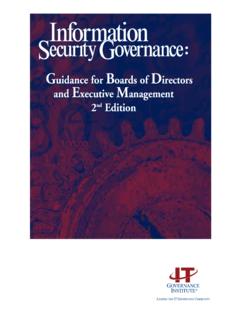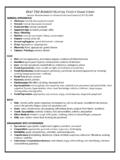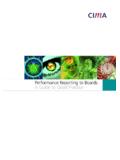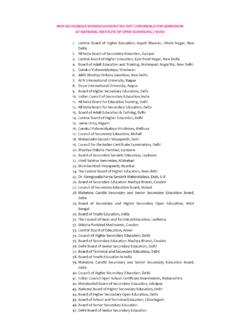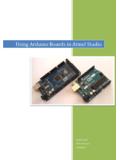Transcription of Early Numeration - Tally Sticks, Counting Boards, and ...
1 Early Numeration - John Alan Halloran - August 10, 2009 - Page 1 Early Numeration - Tally Sticks, Counting Boards, and Sumerian Proto-Writing John Alan Halloran Work on the published version of my Sumerian Lexicon (Logogram Publishing: 2006) has revealed that: 1) the Early Sumerians used wooden Tally sticks for Counting ; 2) Tally marks led to proto-writing; 3) the Sumerian pictograms for goats and sheep probably derive from Tally stick notch conventions; 4) the Uruk period civilization used Counting boards; 5) the authors of the proto-cuneiform tablets drew with animal claws or bird talons; 6) the historical Sumerians used clay split tallies as credit instruments; and 7) the Sumerians may sometimes have counted by placing knots or stones on a string.
2 1. Counting with Wooden Tally Sticks The following text caught my attention. It is from The Debate between Sheep and Grain, ETCSL , lines 130-133: "Every night your count is made and your Tally - stick put into the ground, so your herdsman can tell people how many ewes there are and how many young lambs, and how many goats and how many young kids." The Sumerian reads: 130 ud u2-u -e ni 2-kas7-zu ba-ni-ak-e 131 i ID-ma-zu ki i3-tag-tag-ge - the Unicode version has i - udum-ma-zu 132 na-gada-zu u8 me-a sila4 tur-tur me-a 133 ud5 me-a ma 2 tur-tur me-a lu2 mu-un-na-ab-be2 is read |sh| and is read |ng|. Taking this passage into account, together with other lexical evidence, my Sumerian Lexicon has the following entry: ita5, iti, it, id, ed, udum, itim2 n.
3 , measure; number ( e3/ u, 'portion', + dim, 'post'; cf., i - udum-ma, 'herder's Tally sticks', and the different readings of ID). v., to count; to consider; to calculate, figure out; to memorize; to recite; to read aloud. This lexicon entry for the Sumerian word for 'measure; number' derives its etymology from two simpler words, e3, 'portion' or u, 'hand(s); share, portion', and dim, 'post, pillar'. Sumerian polysyllabic words which are not loanwords from Akkadian can usually be analyzed as compounds of simpler monosyllabic words. The introduction to my Sumerian Lexicon says, "in view of the Sumerians observed propensity for forming new words through compounding in the period after they invented cuneiform signs, it should not surprise anyone to find that this same propensity was at work in the logogram words that mostly date from before their invention of written signs.
4 " This refers to the fact that 75% of the entries in my published lexicon are transparent compounds of words, each of Early Numeration - John Alan Halloran - August 10, 2009 - Page 2 which have their own written signs. But I claim that many Sumerian words that have just one written sign also result etymologically from a combination of two simpler words. As a spoken language, Sumerian had a long history before the invention of writing. So I think that many Sumerian words are the result of compounding during that long time period. The etymology of udum, 'to count', which involves simple Sumerian words for 'portion' and 'post or stake', appears to be strong. The vowel and consonant changes are normal because the language tries to achieve phonetic harmony through different types of assimilation including vowel harmony.
5 The etymology, referring to notched Tally sticks put into the ground by shepherds, describes the origin in Sumerian of number Counting . What exactly is a Tally stick ? One cannot surpass the very learned, illustrated 28-page Tally Sticks chapter in Number Words and Number Symbols: A Cultural History of Numbers, by Karl Menninger. [Originally published in German as Zahlwort und Ziffer in 1934 and 1958, Press published a revised English edition in 1969. They describe him as a "distinguished German scholar" whose "work embraces the full span of recorded history as it unfolded in cultures throughout the world." His investigation of worldwide Counting practices can help clarify the meaning and function of evidence and practices that are found in a particular culture.]
6 ] The simplest Tally stick is a number stick , a stick with as many notches as what the owner wanted to record. Humans have made these notches not just in wood, but also in bone, ivory, shell, and rock. Menninger says, "Number sticks have been used in every period and by all peoples." (p. 226). The illiterate, unschooled farmer still "had to keep track of his crops and livestock and harvests. The peasant could also be a creditor or a debtor. Where did he get the numerals to reckon with?" "From no one but himself! He developed his own number signs, which were adequate for his own ordinary dealings, and which no one but himself could read and understand." (p. 223) "In the history of language, this is the earliest forerunner of the art of writing.
7 " (pp. 223-24) Before writing represented spoken language and before there were standardized systems, illiterate farmers and merchants used idiosyncratic systems of their own devising to record quantities of products. This is not sufficiently recognized in modern works on the origin of writing. Tallies to record commodity quantities were idiosyncratic symbolic marks that did not necessarily have phonetic counterparts. Written signs originated to meet everyday needs, not to represent spoken language. Menninger traces the words for writing in many languages back to words for carving, cutting, or scratching. Furthermore, in bound collections of notched Tally sticks or tablets of beech wood he sees the ancestor of the modern buch or book.
8 He also convincingly traces the basic Roman numerals to Tally stick notation conventions. It should help students trying to decipher examples of proto-writing from different cultures to learn that, "A study of Tally sticks reveals two very important things about Early written numerals: "The crossing of a carved symbol most frequently means a grouping, usually 10. "Half the symbol stands for half its normal value." (p. 242) Thus when X means 10, V means 5 - see the Wikipedia article about Roman numerals, Origins at Early Numeration - John Alan Halloran - August 10, 2009 - Page 3 2. Proto-Writing and Tally Marks The Tally stick conventions described by Menninger appear also to have inspired the Early script of Old Europe, which developed in the middle and lower Danube basin starting around 5,300 BCE, calibrated.
9 Although different theories have been proposed about the signs found on 940 inscribed objects excavated from the Vin a-Tordos region of Transylvania, Eric Lewin Altschuler and Nicholas Christenfeld have shown that nearly one-third of the inscribed pottery objects bear numerical inscriptions. They suggest that the script of Old Europe may have been used for economic purposes, The Number System of the Old European Script, 9 Sep 2003, [ ] at A literature search fails to find any student of this ancient script who references the Tally marks chapter of Menninger's book, probably because nothing about the title, Number Words and Number Symbols, indicates that it is about the history of writing, However, if one goes back far enough, economic Tally marks are very relevant to the origins of writing.
10 Altschuler and Christenfeld describe how to read the number signs on the Old European Script ('OES') inscriptions - the score marks, the 'comb' motif, and the 'telephone pole' motif. They suggest that the common OES signs V and X or + should be read as 10 and 20. Then, confirming Menninger's description of Tally marks as informal writing meant to be read only by its users, Lewin and Christenfeld say, "It might be wondered why the same number is written in more than one way. For a number of reasons we think this is not surprising and is probably even expected. First, as the script was in use for hundreds of years over hundreds of square kilometers we would expect some variation. Second, it must be remembered that standardization is a concept of modernity.


